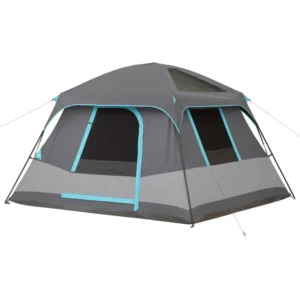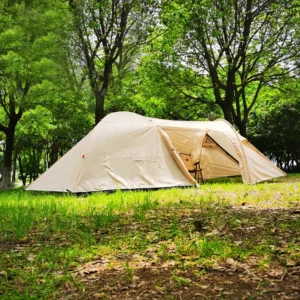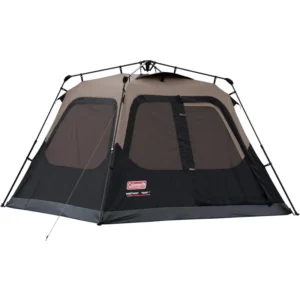Introduction
Family camping trips create lasting memories, but they often come with challenges that can test even the most patient parents. Limited space, lack of privacy, and the chaos of gear scattered throughout a single tent area can quickly transform a peaceful getaway into a stressful experience. This is where two-room tents offer a game-changing solution for families.
Two-room tents feature separate compartments divided by walls or panels that create distinct spaces within a single tent structure. Unlike traditional single-room tents that offer one open area, these innovative designs provide physical separation that transforms how families experience camping.
For families in particular, the benefits extend far beyond just having extra square footage. The thoughtful division of space addresses common camping frustrations while enhancing comfort and enjoyment for everyone. When designed well, these specialized shelters can turn family camping from an exercise in patience to a genuinely enjoyable adventure where everyone has their needs met.
In this article, we’ll explore how these advantages can fundamentally improve your family’s outdoor experiences. From addressing common shelter options for two campers to meeting the unique needs of larger family groups, these tents offer solutions that transform camping comfort and enjoyment for everyone.
Understanding Two-Room Tent Designs for Families
Two-room tents fundamentally revolve around creating separated spaces within a single structure. Most designs feature divider walls or panels that can be zipped or unzipped, allowing flexibility in how you use the space. Many models also include multiple entrances, enabling family members to come and go without disturbing others.
The market offers several distinct configuration types to suit different family preferences:
Cabin-style tents: Feature near-vertical walls that maximize interior space and headroom, often with room dividers that create distinctly separate areas. These provide the most “home-like” feeling with standing room throughout.
Tunnel-style tents: Built with a series of curved poles creating a long, tunnel-shaped structure with rooms arranged in sequence. These excel in weather resistance and typically offer excellent space efficiency.
Dome with attached screen room: Combines a traditional dome sleeping area with an attached screen room that can serve as a second sleeping area or living space. These tend to be lighter and easier to set up than cabin styles.
Most family-oriented two-room tents offer between 80-120 square feet (7.4-11.1 square meters) of floor space, standing heights around 6-7 feet (1.8-2.1 meters), and capacity ratings for 6-10 people. The size you choose should consider not just the number of family members but your desired comfort level and how much gear you’ll store inside.
Understanding these design options for dual-room tents will help you envision how your family might use the space and which configuration might best match your camping style.
Enhanced Privacy: Creating Personal Space for Everyone
One of the most immediate benefits of two-room tents is the psychological impact of having separated spaces. This physical division creates a sense of personal territory that can dramatically improve the camping experience for everyone involved.
For parents, having a dedicated sleeping area means the possibility of adult conversations, intimate moments, or simply unwinding without constant supervision of children. Meanwhile, children benefit from having their own space where they can play, chat, or sleep according to their own schedule.
The privacy advantages become particularly apparent across different family scenarios:
Families with young children: Parents can put little ones to bed in one room while maintaining normal conversation volume and light in the other space.
Families with teenagers: Older kids appreciate having their own domain where they can have some independence while still being safely within the family tent.
Multi-generational camping: Grandparents can have their own quiet space while still participating in the family camping experience.
Most two-room tents feature dividers that can be opened during the day and closed at night, providing flexibility based on your family’s changing needs. While these dividers don’t create soundproof rooms, they do reduce noise transfer significantly and create visual privacy that can make a world of difference after days together in the outdoors.
The psychological comfort of having two-room tents transform camping privacy cannot be overstated—it’s often the difference between family members merely tolerating a camping trip and genuinely enjoying it.
Superior Organization and Clutter-Free Living
The organizational benefits of two-room tents extend far beyond simple space division. These tents transform how families manage their gear and daily activities, creating a more harmonious camping experience.
With designated areas for different purposes, you can:
- Keep sleeping areas completely free of equipment, creating a clean, sanctuary-like space for rest
- Establish a dedicated gear room where backpacks, shoes, and equipment stay organized
- Create specific zones for activities like changing clothes, preparing for hikes, or playing games
- Maintain a “clean zone” policy in sleeping areas that prevents dirt, sand, and debris from affecting sleep quality
Many families use one room exclusively for sleeping and the other as a multipurpose space for storage, changing, and socializing. This separation prevents the frustration of searching through piles of mixed gear and reduces the stress of constant tidying.
The “mudroom” concept is particularly valuable in wet conditions. Having a dedicated space where wet boots, jackets, and equipment can dry without soaking sleeping bags and personal items makes rainy camping trips much more manageable. It also provides a buffer zone between the outdoors and your sleeping area, significantly reducing how much dirt and moisture enters your primary living space.
Explore Elements offers several two-room camping tent options specifically designed with organizational features like internal pockets, gear lofts, and thoughtful door placements that enhance this natural separation of functions.
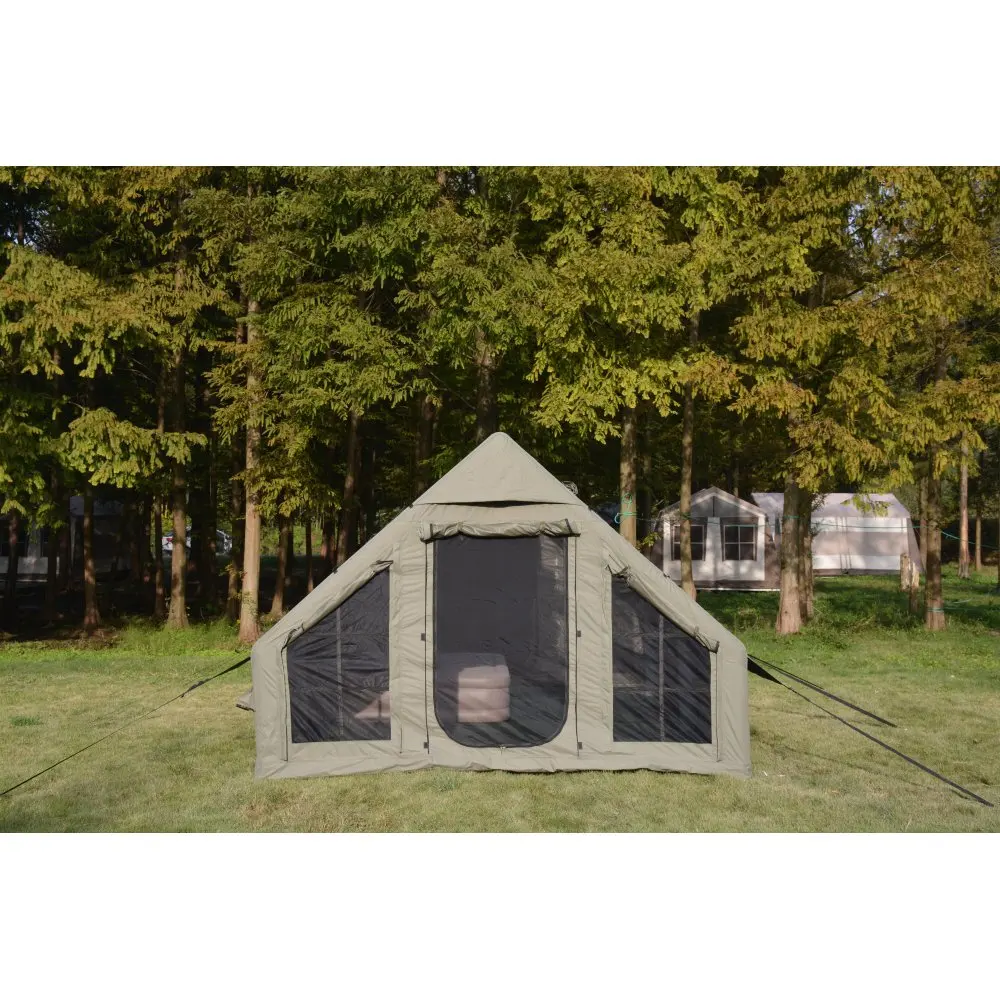
Creating Versatile Living Spaces
The true magic of two-room tents lies in their remarkable adaptability. Unlike single-room designs, these tents can transform throughout your trip to meet changing needs and weather conditions.
Consider these creative uses for your second room:
Rainy day play haven: Set up the second room with games, coloring books, or toys to keep children entertained during inclement weather without crowding sleeping areas.
Dining sanctuary: Place a small folding table and chairs in one section to create a bug-free dining area where the family can enjoy meals regardless of weather.
Morning/evening transition zone: Early risers can move to the second room to prepare for the day without disturbing those still sleeping.
Pet retreat: Create a dedicated space for four-legged family members that keeps pet hair and muddy paws contained.
Remote work station: For those mixing work and pleasure, establish a temporary office space with camping table and power bank for devices.
Gear drying station: After wet adventures, convert one room into a drying area with clotheslines strung across for wet swimsuits and towels.
The ability to reconfigure your space depending on daily needs makes two-room tents particularly valuable for longer trips where weather and activities vary. This versatility becomes even more apparent when considering various uses for two-room tents in group camping situations where different members have different schedules and needs.
Weather Protection and Extended Comfort
Two-room tents offer significant advantages when facing challenging weather conditions, turning what could be trip-ending situations into manageable circumstances.
During rainstorms, the separated spaces allow you to maintain a completely dry sleeping area while dealing with wet gear and clothing in the second room. This prevents the all-too-common scenario where everything becomes damp from wet raincoats and boots stored in the same space where you sleep.
In hot weather, the multiple doors and windows typical of two-room designs create excellent cross-ventilation options. You can create cooling air flows through the tent while still maintaining privacy, significantly reducing the stuffy, sauna-like conditions common in single-room tents.
For cold-weather camping, the room separation allows for temperature zone management. The sleeping area can be kept warmer through body heat concentration, while the second room serves as a buffer zone that insulates against the coldest exterior temperatures.
Extended periods of challenging weather become much more bearable when families aren’t constantly on top of one another in a confined space. Having separate areas means children can play or adults can read while others nap, preventing the cabin fever that often cuts camping trips short when weather turns unfavorable.
For maximum protection in various conditions, look for waterproof camping tent options with sealed seams, quality waterproof ratings, and sturdy pole structures that stand up to wind and precipitation while maintaining the advantage of separate living spaces.
Improved Sleep Quality for the Whole Family
Perhaps no advantage of two-room tents is more appreciated than their ability to improve sleep quality for every family member. Good sleep transforms the entire camping experience, and room separation directly addresses the most common sleep disruptors.
The divided spaces particularly benefit:
Different sleep schedules: Early risers can prepare for the day without waking others, while night owls can read or talk quietly without disturbing those already asleep.
Light sleepers: Even minor disturbances like rustling sleeping bags or bright headlamps can be contained to one room.
Varying comfort preferences: Some family members might prefer cooler sleeping conditions while others want warmth, and separate rooms allow for this customization.
Snorers: The dividing wall provides at least some buffer against loud breathing or snoring that would otherwise wake everyone in a single space.
The improved rest that comes from addressing these common issues cannot be overstated. Families often report that the difference between using a standard tent and a two-room model is the difference between “surviving” a camping trip and genuinely enjoying it.
For families wondering about space requirements, understanding whether a 2-person tent is actually big enough for comfortable sleep helps put into perspective why the expanded space of two-room designs makes such a difference for family groups.
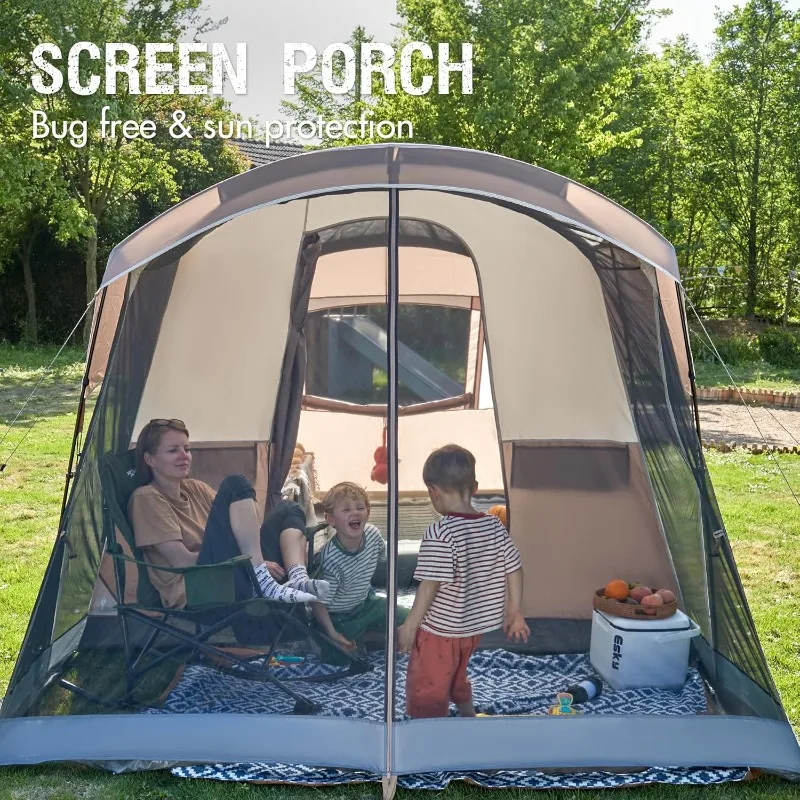
Family Dynamics: Balancing Togetherness and Individual Needs
Two-room tents offer a unique solution to one of family camping’s greatest challenges: balancing quality togetherness with necessary personal space. This balance is crucial for maintaining harmony when families spend concentrated time together in outdoor settings.
The physical separation provides emotional breathing room that helps prevent the tension that often builds during extended family time. Children can retreat to “their room” when needing downtime, while parents can have conversations or moments alone without leaving the tent entirely.
This design accommodates various family stages particularly well:
Families with infants: Parents can maintain nap schedules in a quiet room while older children play in the second space.
Families with wide age gaps: Teenagers can have privacy and autonomy while younger siblings follow an earlier schedule.
Extended family camping: Different family units can maintain some separation while still sharing the camping experience.
The two-room structure naturally reduces common friction points like the mess of one family member affecting everyone’s space, or different sleep schedules forcing everyone to the earliest bedtime. When evaluating your options, comparing two-room tent layouts and sizes can help you find the arrangement that best supports your specific family dynamics.
Smart Setup and Flow Management
The thoughtful design of two-room tents enables families to establish efficient daily routines that make camping feel less chaotic and more like a well-organized vacation.
Strategic advantages of these designs include:
Reduced bottlenecks: Multiple entrances allow family members to enter and exit without crowding one doorway.
Circular traffic patterns: Many designs enable one-way flow through the tent, reducing congestion during busy morning or evening routines.
Clean/dirty separation: Establish one entrance as the “dirty” entrance for returning from activities, with a second “clean” entrance for accessing sleeping areas.
Morning staging area: Early risers can prepare in one room while others sleep, then smoothly transition outside without disruption.
To maximize these benefits, consider placing gear that will be needed first thing in the morning (like toiletries or day clothes) in easily accessible locations near the exits. Similarly, designate specific areas for nighttime essentials to create smooth bedtime routines.
For families who prioritize quick campsite setup, easy setup camping tent options provide the benefits of two-room designs without complex or time-consuming assembly processes, making arrival day much less stressful.
Tall / Stand Up Camping Tent, Two Room Camping Tent
$407.93 Select options This product has multiple variants. The options may be chosen on the product pageCompact Backpacking Tent, Lightweight Backpacking Tent, Waterproof Camping Tent
$335.52 Select options This product has multiple variants. The options may be chosen on the product pageCamping Tent with Vestibule, Waterproof Camping Tent
Price range: $407.89 through $479.48 Select options This product has multiple variants. The options may be chosen on the product page- $476.52 Select options This product has multiple variants. The options may be chosen on the product page
Backpacking Tent with Vestibule, Trekking Pole Backpacking Tent, Waterproof Camping Tent
Price range: $271.99 through $519.52 Select options This product has multiple variants. The options may be chosen on the product pageEasy Setup Camping Tent, Instant Camping Tent
Instant Cabin Tent Double Layer Canvas 1-Minute Setup Spacious Family Camping Shelter with Air Vents$308.10 Select options This product has multiple variants. The options may be chosen on the product page
Considerations Before Choosing a Two-Room Family Tent
While two-room tents offer significant advantages, they also come with considerations that families should weigh before purchasing:
Campsite requirements: These tents typically have a larger footprint, requiring more substantial tent pads or flat areas. Always check the dimensions against typical campsites at your favorite destinations.
Setup complexity: The additional rooms, poles, and features can make some models more time-consuming to pitch. Factor in 15-30 minutes of additional setup time compared to simpler designs.
Weight and bulk: Two-room family tents generally weigh between 20-35 pounds (9-16 kg) and have larger packed sizes, making them less suitable for backpacking or campsites requiring long carries from parking areas.
Cost considerations: Expect to invest more initially—typically 30-50% higher than comparable quality single-room tents—though the versatility often justifies this premium for frequent campers.
Ventilation management: The multiple rooms require thoughtful adjustment of windows and doors to maintain optimal airflow throughout the entire structure.
These factors aren’t necessarily disadvantages but rather considerations that help determine if a two-room tent matches your camping style. For many families, learning the basics of mastering two-person lightweight tent setup can provide valuable skills that transfer to larger tent management.
Making the Most of Your Two-Room Tent: Expert Tips
To maximize the benefits of your two-room tent, experienced family campers recommend these practical strategies:
Pre-plan room allocations: Decide before your trip which room will serve which function, and pack accordingly in separate duffels or containers.
Implement vertical storage: Use hanging organizers or create temporary clotheslines to keep floor space clear and maximize usable area in both rooms.
Create visual cues: Use different colored mats or lights in each room to help young children understand the purpose and boundaries of different spaces.
Pack strategically: Store items in clear containers labeled by room and function to eliminate rummaging through bags.
Practice setup at home: Familiarize everyone with their role in pitching the tent to streamline the process upon arrival at the campsite.
Consider a ground tarp arrangement: Use separate ground cloths under each room section for easier cleaning and maintenance.
For those who value quick setup after a long drive to the campsite, instant camping tent designs combine room separation with rapid deployment systems that can have your shelter ready in minutes rather than half an hour.
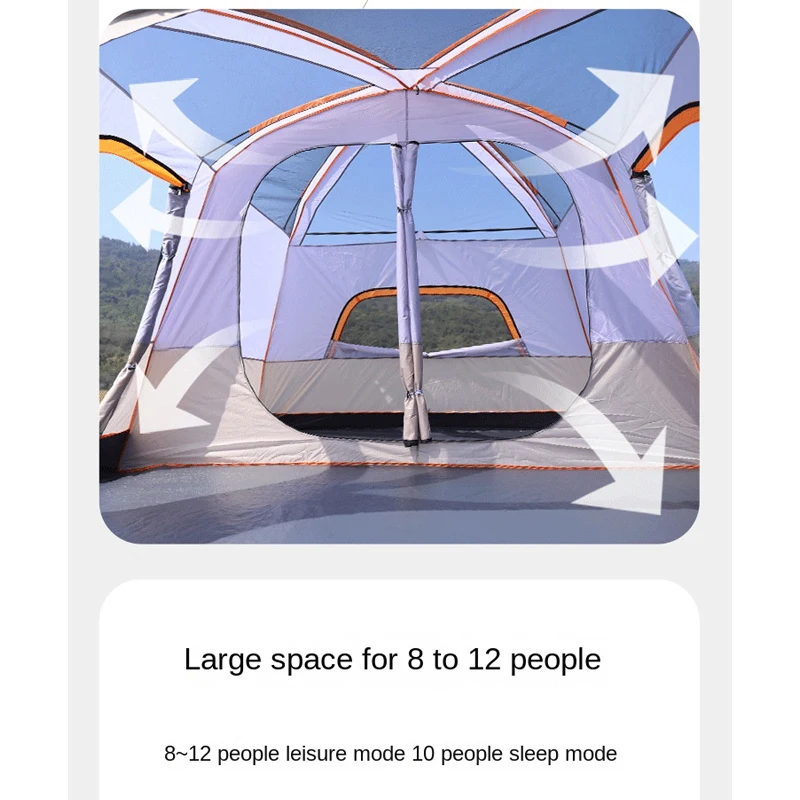
Is a Two-Room Tent Right for Your Family?
When would a two-room tent be the ideal choice for your family?
Two-room tents deliver the greatest value for families who camp for extended periods (3+ days at a time), have children of different ages with varying schedules, regularly camp in variable weather conditions, or simply prioritize comfort and organization in their outdoor experiences.
When might a simpler tent suffice?
If you primarily take overnight or weekend trips in predictable weather, have children all of similar ages with the same schedules, or camp in areas with very limited tent pad sizes, you might find a high-quality single-room tent adequate.
Will the benefits justify the investment for occasional campers?
Even for families who camp just 2-3 times annually, the privacy and organizational benefits often transform the experience enough to justify the additional cost, especially if those trips are longer than a weekend.
Does family size determine the need for a two-room tent?
Not necessarily—even smaller families of three or four often find tremendous value in the room separation, particularly when camping for extended periods or in challenging conditions.
For families who value standing height throughout their tent, tall stand-up camping tent options provide the vertical space that makes changing clothes and moving around much more comfortable, further enhancing the two-room advantage.
The primary question to ask isn’t just whether your family needs a two-room tent, but rather how much you value comfort, privacy, and organization in your outdoor adventures. For most families, once they experience the advantages of properly separated spaces, they rarely return to single-room designs.


